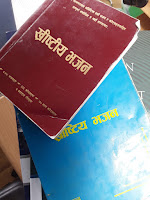Baikuntha to Sworga: Changing Lyrics of a Nepali Christian Hymn and Theological Consciousness of Nepali Christians
 |
| Nepali Hymnals (Blue Older version, Brown- Newer version) |
By: Pabitra M. Bhandari
In Nepali Christian communities, Nepali
hymnal takes a central stage. There are very few Christian meetings in Nepal that
do not start with singing hymns.[1] And you
will find very few Christians who would go to church without a hymnal along with his
Bible.[2] One of the earliest forms of contextualization of Christianity happened in the Nepali
Christian songs. Rather than depending on translated hymns alone, from the beginning,
Nepali Christians created Nepali Christian hymns they are very traditional in melody
and sung with Nepali traditional instruments. John Barclay, who wrote an
account of early church growth in Nepal states that the development of such Nepali indigenous
songs was one of the factors that cause the growth of Nepali Christianity. [3]
Among many indigenous Nepali
songs, there is one quite popular in Nepal, that’s hymn no 502 in New version
of hymnal or chorus no. 111 in older versions. The song title is herana hera
sristiko sundarta (हेर न हेर सृष्टिको सुन्दरता), meaning ‘look
at the beauty of God’s creation’. This
song contains the lines that declare God’s creative act and calls for
all to glorify to the creator. It also calls a very sociologically important
line: all differences between people have been erased. This line is very
important because Nepal is a society that is fragmented in various castes and people
groups.[4] And discrimination
between people is very strong. In this way, we can call this Nepali hymn is an
infant Nepali liberation theology as well. This Nepali hymn can be taken as a
Nepali theology that spoke their belief on God in their own indigenous method
of singing and related to their own unique social problem of caste-system.
However, the hymn, herana hera
sristiko sundarta, went through a revision and change of some certain words that
highlight a new theological consciousness of Nepali Christians.[5] The change
happened in the second verse of the song. The word Baikuntha is replaced with
sworga. We should note that there is no single mention of Jesus in the song,
and not only the Christian, but it can also fit within any other religious groups.[6] Baikuntha
is a word that denotes some paradise kind of place where lord Vishnu of Hinduism
lives. Baikuntha is not used in the bible to talk about heaven or the kingdom of
God. The new word sworga is a place where Indra, the king of Hindu gods lives,
and this word is adopted in the Bible to replace the world heaven in Nepal. The
revision of the hymn did not make the song more Christian in any way, it is
still cannot be identified to be a Christian song if a non-Christian hears it.
It only replaces one Hindu word to anther Hindu word.
Does Sworga speak of the heaven
the Bible seeks to promise for us? In what way Sworga is better than Baikuntha?
Sworga in the Bible and Hinduism are different because we use the word sworga
for a different belief and theology than the Hindus. It is our belief that gives
the different meanings not the word itself. Baikuntha can also mean significant not
it is the place of Vishnu, but because of our faith in Lord Jesus Christ. Nepalis
we often put emphasis on the symbols and words than the theology behind it. We
are hesitant to use the symbols used by other religious people in order to be
different from them. However, we should note that we are different from Hindus
and others in society it is not because our ladies do not wear sindur, tika,
or at our wedding, we wear white gowns not red saris. We are different because
we believe in the Lord Jesus Christ, the forgiveness of sin, we seek to live
according to God’s calling.
[1] Victoria Marie Dalzell, “Our Hymn Numbers are More Sacred Than Bible Verses”: Forming Nepali Christian Identity Through Music, MA
Thesis, University of California Riverside, 2010. Dalzell had researched on the
importance of hymns in Nepali Christian community.
[2] However,
this claim is being changed due to digital media available, and younger generations
are depending more on mobile apps for the Bible and hymnal.
[3] John
Barclay, “The Church in Nepal: Analysis of Its Gestation and Growth,”
International Bulletin of Missionary Research, Vol. 33, No. 4, (October
2009): 193.
[4] Though various
people groups in Nepal do not need a reference to proof, I would like to
mention Dor B. Bista’s book as an example to show the
existence of people groups in Nepal. Bista introduces Nepali people group
according to their caste, ethnicities and hierarchy in the society. Dor B.
Bista, People of Nepal, (Kathmandu: Ratna Pustak Bhandar, 1996), 1ff.
[5] Nepali
Khristiya Bhajan (Kathmandu, Samdan prakashan, 2011), 269; Khristiya Bhajan
(Kathmandu: Jivan Marga Prakashan, 2011), 250.
[6] I was
told by one of my friends that even Hare-Hare, a new Hindu movement popular in Nepal,
sing this song in their religious meetings. The authenticity of this claim needs
to be verified, but I do not see the impossibility of such, because by reading
the world of this hymn there is no indication that it is a Christian song.
